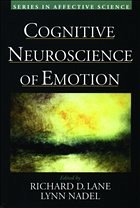This book, a member of the Series in Affective Science, is a unique interdisciplinary sequence of articles on the cognitive neuroscience of emotion by some of the most well-known researchers in the area. It explores what is known about cognitive processes in emotion at the same time it reviews the processes and anatomical structures involved in emotion, determining whether there is something about emotion and its neural substrates that requires they be studied as a separate domain. Divided into four major focal points and presenting research that has been performed in the last decade, this book covers the process of emotion generation, the functions of amygdala, the conscious experience of emotion, and emotion regulation and dysregulation. Collectively, the chapters constitute a broad but selective survey of current knowledge about emotion and the brain, and they all address the close association between cognitive and emotional processes. By bringing together diverse strands of investigation with the aim of documenting current understanding of how emotion is instantiated in the brain, this book will be of use to scientists, researchers, and advanced students of psychology and neuroscience.
With the introduction of new brain scanning methods -- fMRI and PET, for example -- the subdiscipline of cognitive neuroscience was born, and, with it, a renewed interest in many areas of cognitive psychology. With these methods, psychologists have been able to pair psychological behavior with substrates in the brain, and for the first time, a technology could allow us to see psychological functioning in real time. The field of emotion has benefited from the introduction of these new technologies, and some of the most prominent figures in cognitive neuroscience have contributed chapters to this collection, a project sponsored by the McDowell-Pew Program in Cognitive Neuroscience. The authors explore the neurology of emotion, the cognitive causes of emotion, blindsight, and other topics at the junction of emotion and cognitive neuroscience.
With the introduction of new brain scanning methods -- fMRI and PET, for example -- the subdiscipline of cognitive neuroscience was born, and, with it, a renewed interest in many areas of cognitive psychology. With these methods, psychologists have been able to pair psychological behavior with substrates in the brain, and for the first time, a technology could allow us to see psychological functioning in real time. The field of emotion has benefited from the introduction of these new technologies, and some of the most prominent figures in cognitive neuroscience have contributed chapters to this collection, a project sponsored by the McDowell-Pew Program in Cognitive Neuroscience. The authors explore the neurology of emotion, the cognitive causes of emotion, blindsight, and other topics at the junction of emotion and cognitive neuroscience.

